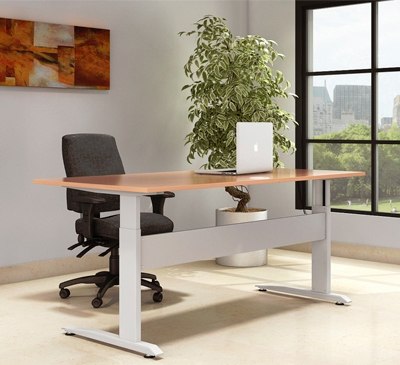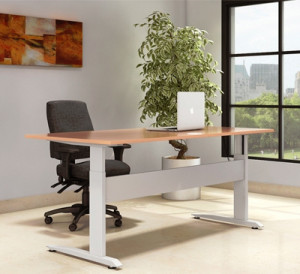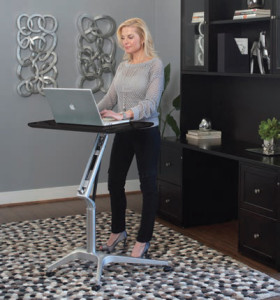Sitting at office desks for long periods of time can be frustrating and tiring, not to mention painful for the back and neck – but did you know that sitting for long periods has also been linked to serious health problems?
While the health issues of sitting all day have been well publicised in recent years, the answer isn’t to try to stand all day either. Changing your working position regularly is more sustainable (and beneficial) than standing for hours on end. Height adjustable sit stand desks are a popular way to reduce the risks, but before we talk about their benefits, let’s take a deeper look at the issue.
How sitting for long periods can affect your health
Australian workers with full time desk jobs spend an average of 6.3 hours a day sitting. According to an article by the Mayo Clinic’s James A. Levine, any regular period of extended sitting can be harmful, and trying to balance that out by spending a few hours a week at the gym doesn’t seem to offset the risks.
The health risks can be serious and include:
Heart disease. When sitting for long periods, our muscles burn less fat and our blood flows more slowly, making it easier for fatty acids to clog the heart.
Muscle degeneration. While sat in a chair, our abdominal or core muscles usually remain switched off – if a person has tight back muscles, sitting for long periods can lead to hyperlordosis (swayback), tight hips and limp glutes (butt muscles).
Bad circulation. After sitting for a period of time, our blood circulation slows, causing fluid to pool in the legs, which can lead to varicose veins and deep vein thrombosis.
Reduced lifespan. As reported by ABC, a recent Australian study showed that people who sat daily for long periods of time watching TV had a greater risk of dying than those who sat for shorter periods.
Along with these physical issues, sitting for long periods of time can result in a loss to workplace productivity. It’s clear that we need to change the way we work.
How standing office desks improve health in the workplace
The Mayo Clinic’s James A. Levine states that standing can help with weight loss by triggering your body to break down fats and sugars. Sitting less can also reduce your risk of heart disease, type II diabetes, muscle degeneration and even cancer, as well as increasing your life span. But if your job relies on paperwork and computers, finding a way to stand more could seem like an impossible idea. That’s where the sit stand office desk comes in.
Sit stand office desks have been referred to as the ‘gold standard’ in ergonomics. They allow users to transition between sitting and standing and their height can be manually or electronically adjusted, depending on the model.
Integrating sit stand office desks into your work place
Fitting out an office or department with sit stand office desks can be a very valuable exercise, but may involve a step change in employee behaviour and workplace culture.
Prior to installation, it’s important to explain the reasons for the change in seating to all employees, as well as the associated health benefits. Once the office has been fitted out, it’s a great idea to appoint an expert to show users how to adjust them correctly so that they are ergonomically suited to their individual needs.
The Australian Heart Foundation recently conducted a case study into the benefits of using sit stand desks in the workplace. Their study found that installing sit stand desks led to an increase in standing time by around an hour each work day. Most of the participants in their study said that they would keep using the workstation, indicating that this new way of working can have a high level of acceptance among office workers.
There are a wide range of sit stand office desks with easy up and down operations at a variety of price points. No fussy, fiddly height adjustments that discourage people from actually gaining the benefits of working at various heights.
What do you think of the sit stand desk? Can you see it being accepted into your office culture?





